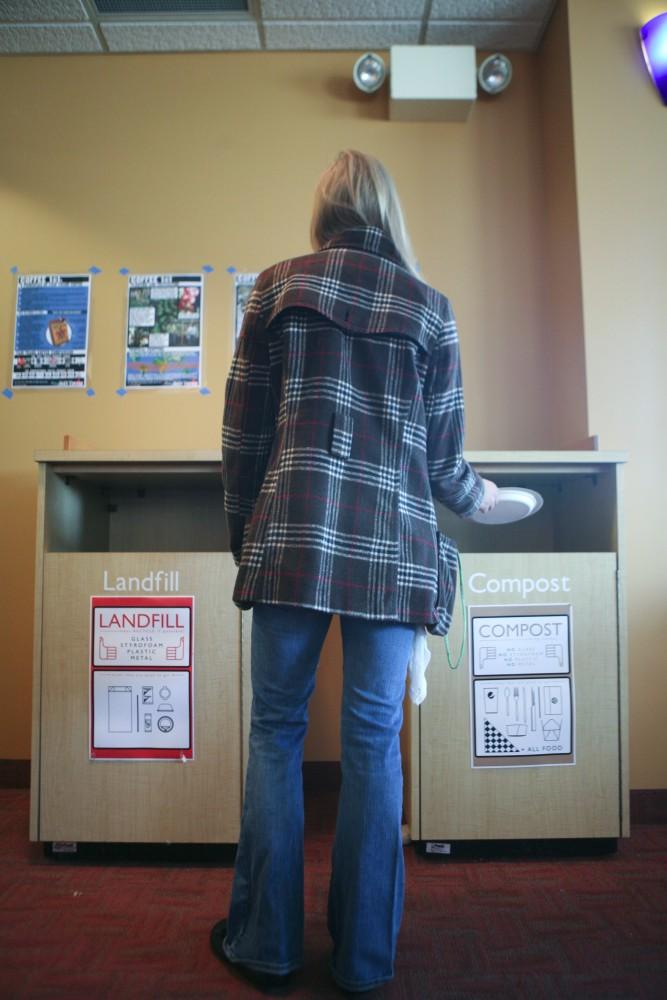Disposal decision: to compost or to landfill?

Sophomore Amber Hendrick tosses a plate into the compost can in Lower Level Kirkhof
Mar 17, 2011
Mealtimes at Grand Valley State University campus dining locations are fast-paced and busy, with students rushing to eat before classes start, conversations at many tables, and the occasional frantic-looking person typing on their laptop without noticing that they’ve dropped ketchup on their textbook.
But after eating, many diners are forced to slow down. They must examine the signs on each pair of trash cans and decide whether or not to put their paper plate, napkin and plastic silverware in the compost bin or send it off to the landfill.
Composting is still a fairly new practice on campus, and many students are still unsure what items can be composted and which must be thrown away. Ethan McCann, the sustainability manager for Campus Dining, said there has been some confusion about the compost bins, which are in every dining location at GVSU.
“We are making changes to the signage on all the trashes to keep up to date and reduce confusion, hopefully going into Spring semester,” McCann said.
Currently, each bin has images posted on it, illustrating what types of items can go in each container. Food waste and other compostable items are picked up by Sprout Industries, said Steve Leeser, operations supervisor from Facilities Services. Sprout Industries processes the waste and turns the material into something similar to topsoil, which can be used in gardens and on farms.
The Campus Dining Green Team, headed by McCann and comprised of students who aim to make campus dining more sustainable and to reduce the university carbon footprint, have been working hard to educate GVSU about the composting program.
“The Green Team has done a nice job of trying to educate people in the eating areas regarding what can be composted,” Leeser said.
Senior Katherine Bauer is a member of the Green Team and has been very involved with the composting that is taking place on campus. Bauer is currently doing a benefit-cost analysis of the composting program.
Bauer, a natural resource management major, has so far found that despite the monetary expense of composting, the environmental benefits outweigh the costs.
“Composting are important primarily because they reduce our carbon footprint,” Bauer said. “Also, reusing materials helps to eliminate waste from entering our landfills, which have numerous problems of their own. The first step that students should take would be to reduce. If our waste volume was reduced even just a little, and students were aware and on board with the composting program, nearly all of our waste could be reused. It just takes time.”
McCann said that, despite some confusion in the campus dining locations, the composting practices and efforts in recycling have been successful.
“I would say both composting and recycling have been very successful so far and will continue to grow as we create better practices,” McCann said. “Each year we have increased our recycling and composting numbers.”
Leeser said that even though the composting program has only been in place for a year and a half, campus is generating 20,000 pounds of compostable waste per week. He added that Kirkhof has been the most successful location on campus so far.
Those numbers, along with other data about campus initiatives in recycling and composting, will be seen in the results of GVSU’s participation in an annual, national recycling competition called Recyclemania, which concludes at the end of the month.
But McCann and others who are involved in the composting efforts have stressed the importance of making an individual effort to compost and keep waste out of the landfills.
“It’s important to reduce the amount of waste by each individual,” McCann said. “Recycling and composting help minimize the waste entering the landfills. The best practice would be to only use what you need and reduce waste in general.”

























